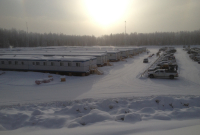Thank you for helping us meet our fundraising goal!
If you’re not quick enough to look right on Highway 16, just after the bridge in Fraser Lake, B.C., you might miss Stellako. About 300 members of the Stellat’en First Nation live in this tidy, quiet village tucked beneath tree-speckled mountains. The local gas station sells Sasquatch memorabilia.
The Stellat'an band is one of 20 First Nations who have signed a Mutual Benefit Agreement (MBA) with TransCanada's Coastal GasLink’s LNG pipeline project.
“At the end it was easy because we negotiated the best deal we could,” said Stellat’an Chief Arthur Patrick. “Natural gas is more benign to the environment than oil and coal. Natural gas will replace coal in other parts of the world, like China. If we can be a part of that replacement, then I think we’re doing the world some good.”
Patrick, 77, portrays the agreement as a relief from “enforced poverty” by governments in a community that used to thrive on now-depleted natural resources.
Coastal GasLink’s 670-kilometre pipeline will carry natural gas from the Dawson Creek area of British Columbia to LNG Canada, a planned liquefaction and export facility near Kitimat, B.C. Pre-construction is underway on the pipeline that will cross Stellat’en traditional territory north of the village.

Although the Stellat’en have lived in harmony with the mountains, wildlife, waterways and fish for many generations, their traditional way of life is barely surviving.
The traditional culture is “pretty much gone now,” Patrick said in an interview with National Observer. “There’s really nothing.”
“All the forest is either burnt or logged all around us. What used to be a plentiful supply of game is gone. Mainstream society has tickets to capture (wildlife) too.”
Dakelh word for Europeans meant ‘ghost of the dead’
Patrick is a residential school survivor and was taken from his home in Stellako when he was nine years old. However, he grew up learning the ways of his ancestors and spoke the Dakelh (Dene) language. He didn’t return to live in Stellako until about eight years ago when he ran for leadership.
Patrick is still fluent in Dakelh. He has witnessed the devastation of colonization first hand. The Dakelh word for Europeans when they first encountered them was “Nawdnikh, ” meaning ghost of the dead.
“We’ve been messed up. Effed up by the colonizers for 150 years and they’re still doing it. They may say that they want to reconcile and all that, but they want us to reconcile,” he said, taking a moment to laugh and shrug his shoulders. “And forgive them for all the stuff that they did to us. But I think they’ve done so much damage that it’s going to be really difficult. It’s going to take several generations to overcome it. In fact, the damage is so bad I don’t know if we can. And you can quote me on that.”
The band is struggling to cope with poverty. It wasn’t hard to make a decision to sign onto the LNG project. If there was nothing left, what was there to lose, was the reasoning for the collective decision to sign on, Patrick said.
Patrick proudly pointed out a row of new houses that are visible from his desk in the administration office. The band scrapped flimsy, government blueprint houses to build sturdy, mould resistant homes that look nice. Band funds were used to top off the project, and it’s deals like the MBA that helped make it a reality.

A new, state-of-the-art, computerized water pump house has been in operation since September, 2018. The federal government funded the installation. Previously the people lived under a ‘do not consume’ water advisory for several years due to arsenic and other contaminants in the groundwater.
“We don’t know what it comes from, but we suspect that all the activity from mining and pollution released the arsenic,” Patrick said. He said there are high levels of cancer and other health issues in the community.
They don’t eat the fish from Fraser Lake anymore because they’re contaminated, he explained.
“Arsenic builds in your system, you can’t get rid of it. We don’t have the resources to test these things. The government doesn’t give a shit. We’re a tiny little band, they don’t spend their resources on us.”
The Endako mine, about a 40-minute drive from the village, suspended operations in 2015 due to a decline in molybdenum prices. Opened in 1965, it is one of the largest molybdenum mines in North America.
Logging is the main industry in the area now.

Agreement with pipeline company a business decision
Stellat’en elders say the community is grateful to receive a cut of the investments from the LNG project. It’s only recently that they were offered a stake in industry developments. In the years since European contact there was very little resource revenue sharing; there was a lot of taking without asking.
Providing jobs and income, the agreement with Coastal GasLink was a business decision.
As far as reconciliation with government goes, Patrick is not optimistic.
“It’s mostly bullshit if you want to quote me. Everything is situation normal. We fight. We get promises. Agreements. But the bureaucracy gets in the way. And now it’s more neglect.”
His anger towards the tumultuous relationship between governments and First Nations softens as he talks about the people he leads. He wants to leave a legacy where the Stellat’en are stronger and healing, where they have jobs, shelter and education.
Language and culture are important too. The MBA funds the village Language Institute. Run by elders and hereditary chiefs, the small space in a newer modular home turned office provides the setting for the reigniting of the Dakelh language. It’s something for which elder Joseph Charlie is grateful.
“The money is being used to revive our traditional government system, the laws we used in our territory… our language is dying, our culture is dying so the government is helping us to revive our language and our culture by giving us financial assistance. They’re doing a good job,” Charlie said in an interview.
No amount of money, however, will ever be enough to repair the damage to the land and people by colonizers, settlers, governments and industry, explained hereditary Chief Geraldine Gunanoot.
“Today we need compensation for everything that was done before and that’s just a small token to give back for something that can revive our identity,” she said in an interview. “If the industry today offers us something, yes, we will gracefully take it and we will use it to revive what has been taken from us. It’s not like they’re doing something great for us. But it is acceptable to us.”
‘We’re going to do the best we can with it’
Band maintenance director Peter Luggi takes pride in his work keeping Stellat’en looking clean, making sure the water treatment plant is running and other jobs that come with the position that he has held for several decades. Almost 10 years ago Luggi started the community garden the size of a baseball field. A celebration dinner is held at harvest, an opportunity for young and old to share in learning about food sovereignty.

He is also a hunter who knows the nearby landscapes like the back of his hand. When he needs food, all he has to do is pack some hunting equipment, a lunch and walk out his back door. From there he climbs the mountain literally steps from his house and goes up and over to the same hunting routes his father and forefathers used before him.
He’s also on board with the pipeline.
“I think we can work together. We need something,” said Luggi. “We have to do something for our community. We have very little trees left in our territory anymore. There is little work left at the mine anymore. No industry here of any sort. As long as our streams and waterways, fish are looked after, and the areas where they put their pipes are supposed to be monitored is a top priority.”
These lands are considered holy to the Stellat’en. There are legends about being able to hear the chanting and singing of a mysterious woman from the spirit world on one nearby mountain. Many believe it’s a Stellat’en ancestor.
“We were hunters and trappers here for years,” said Patrick. “There are troubles all around us. We are wounded as well, so we tend to fight each other before we do anything else. But our resources we’re getting from Coastal GasLink, we’re going to do the best we can with it.”
This is one in a series of stories by reporter Brandi Morin from four of the 20 First Nation communities with agreements allowing the Coastal GasLink pipeline and liquefied natural gas project on their territory.





Comments
Sad that our environment is a trade-off. Horizontal, hydraulic fracturing (an integral component of the LNG industry - fracking) is in in no way environmentally friendly...in fact it is a major polluter to our air, land and water. Commerce trumps the sustainability of our planet yet again....and politicians smile from the other side of their mouths.
Actually it's much worse than oil and coal. The methane emitted by burning natural gas releases at least 50% more carbon than oil does. Emissions from natural gas (methane) have a shorter life span than carbon emissions, but are significantly more intense for the first 10 years. And everybody is tracking these days, especially the U.S., the new #1 supplier of global fossil fuels. The climate deniers solution to mitigating carbon emissions - a "bridge" between fossil fuels and renewables.
Isn't the shorter life span exactly what is needed to mitigate long term damage during the necessary transition? Besides that, coal itself is just plain filthy, even the sucked clean variety. Even without climate change it should be abandoned rather quickly.
Every culture has to adapt. No traditional culture truly survives the way many first Nations seem to want their to survive as a living culture the same as it was generations ago. The best you can hope for are artifacts of that kind of tradition with a modern "interpretation" showing some roots to that old extinct way of life.